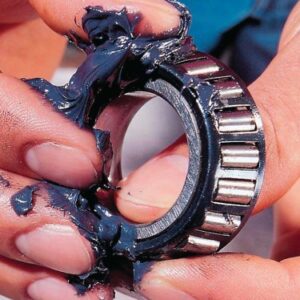 Some engineers see lubricants as a straightforward, messy ancillary of the industrial age. However, much like rolling-element bearings themselves, lubrication is an ancient technology that’s highly engineered in modern forms. In fact, engineers have used fluids to reduce friction thousands of years, but the advent of the oil industry in the late 19th century spurred modern bearing lubrication. Today, bearing lubricants serve several functions:
Some engineers see lubricants as a straightforward, messy ancillary of the industrial age. However, much like rolling-element bearings themselves, lubrication is an ancient technology that’s highly engineered in modern forms. In fact, engineers have used fluids to reduce friction thousands of years, but the advent of the oil industry in the late 19th century spurred modern bearing lubrication. Today, bearing lubricants serve several functions:
Creating a barrier between rolling contact surfaces
Creating a barrier between sliding contact surfaces
Protecting surfaces from corrosion
Sealing against contaminants
Providing heat transference (in the case of oil lubricant)
Lubricants take the form of either oil or grease. Oil lubricants are most common in high speed, high-temperature applications that need heat transfer away from working bearing surfaces. Bearing oils are either a natural mineral oil with additives to prevent rust and oxidation or a synthetic oil. In synthetic oils the base is usually polyalphaolefins (PAO), polyalkylene glycols (PAG) and esters. Although similar, synthetic and mineral oils offer different properties and are not interchangeable. Mineral oils are the more common of the two.
The most important characteristic when specifying oil for a bearing is viscosity. Viscosity is a measure of a fluid’s internal friction or resistance to flow. High-viscosity fluids are thicker like honey; low-viscosity fluids are thinner like water. Engineers express fluid resistance to flow in Saybolt Universal Seconds (SUS) and centistokes (mm2/sec, cSt). The difference in viscosity at different temperatures is the viscosity index (VI). An oil’s viscosity is correlative to the film thickness it can create. This thickness is crucial to the separation of the rolling and sliding elements in a bearing. Bearings in some applications use oil, but grease is the lubricant of choice for 80 to 90% of bearings.
Grease consists of about 85% mineral or synthetic oil with thickeners rounding out the rest of the grease volume.
The thickeners are usually lithium, calcium or sodium-based metallic soaps. Formulations for higher-temperature applications often include polyurea. The higher viscosity of grease helps contain it within the bearing envelope. The most important considerations when choosing a grease are the base oil viscosity, rust-inhibiting capabilities, operating temperature range and load-carrying capabilities.
Check out the 5 best bearing lubrication videos on the internet here.


I didn’t know something like viscosity would really make a difference with different moving parts. I know that many parts need to be able to reduce friction as much as they can’ with how lubricants work I thought that viscosity wouldn’t play a huge factor because it would just make the parts move together easily. I will definitely find out what kind of lubrication my parts will actually use.
Why the oil lubrication is used in pumps and grease lubrication is used in motor for Anti friction bearings?